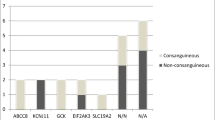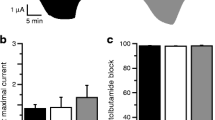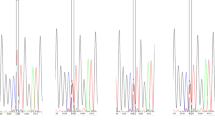Abstract
Background: Activating mutations of potassium inwardly-rectifying channel, subfamily J, member 11 (KCNJ11), which encodes Kir6.2 (beta-cell adenosine triphosphate-sensitive potassium [KATP] channel subunit), have been associated with neonatal diabetes mellitus (NDM) in different studies. Treatment with oral sulfonylureas in place of exogenous insulin injections results in improved glycemic control in most patients carrying these mutations. Exploration of genetic causes of NDM occurring before the age of 6 months has been proposed as an important issue in identification of monogenic forms of diabetes, which might be critical in their therapeutic management, as a consequence.
Methods: Mutation screening of the KCNJ11 gene was carried out using PCR amplification followed by direct sequencing in three family members: the proband, ND1, diagnosed at 40 days of age (current age 7 years); his sibling, ND2, diagnosed at 2 years of age (current age 14 years); and their father, ND3, diagnosed at 15 years of age (current age 35 years), who had been exclusively treated with insulin. The effect of the E227K mutation was also examined in a homology model of Kir6.2.
Results: Our results revealed the presence of the heterozygous missense mutation c. 679 G/A (E227K) in all three patients, who were all able to successfully transfer from insulin injections to an oral sulfonylurea, with improved glycemic control.
Conclusion: We found that three members of a family with highly variable age of onset of insulin-treated diabetes, diagnosed at 40 days, 2 years, and 15 years of age, all carried the E227K mutation in KCNJ11 and could switch to an oral sulfonylurea. This mutation has been previously reported in patients with permanent and transient NDM, as well as later-onset diabetes; this report adds to the variability in phenotypic presentation and further supports genetic testing in all diabetic members of any family affected by NDM.

Similar content being viewed by others
References
Sperling MA. ATP-sensitive potassium channels: neonatal diabetes mellitus and beyond. N Engl J Med 2006 Aug 3; 355(5): 507–10
Sperling MA. Neonatal diabetes mellitus: from understudy to center stage. Curr Opin Pediatr 2005 Aug; 17(4): 512–8
Slingerland AS, Shields BM, Flanagan SE, et al. Referral rates for diagnostic testing support an incidence of permanent neonatal diabetes in three European countries of at least 1 in 260,000 live births. Diabetologia 2009 Aug; 52(8): 1683–5
Iafusco D, Massa O, Pasquino B, et al. Minimal incidence of neonatal/infancy onset diabetes in Italy is 1:90,000 live births. Acta Diabetol. Epub 2011 Sep 28
Polak M, Shield J. Neonatal and very-early-onset diabetes mellitus. Semin Neonatol 2004 Feb; 9(1): 59–65
Metz C, Cavé H, Bertrand AM, et al., NDM French Study Group. Neonatal diabetes mellitus: chromosomal analysis in transient and permanent cases. J Pediatr 2002 Oct; 141(4): 483–9
Flanagan SE, Edghill EL, Gloyn AL, et al. Mutations in KCNJ11, which encodes Kir6.2, are a common cause of diabetes diagnosed in the first 6 months of life, with the phenotype determined by genotype. Diabetologia 2006 Jun; 49(6): 1190–7
Edghill EL, Dix RJ, Flanagan SE, et al. HLA genotyping supports a non-autoimmune etiology in patients diagnosed with diabetes under the age of 6 months. Diabetes 2006 Jun; 55(6): 1895–8
Greeley SA, Tucker SE, Naylor RN, et al. Neonatal diabetes mellitus: a model for personalized medicine. Trends Endocrinol Metab 2010 Aug; 21(8): 464–72
Colombo C, Porzio O, Liu M, et al., Early Onset Diabetes Study Group of the Italian Society of Pediatric Endocrinology and Diabetes (SIEDP). Seven mutations in the human insulin gene linked to permanent neonatal/infancyonset diabetes mellitus. J Clin Invest 2008 Jun; 118(6): 2148–56
Tarasov AI, Girard CA, Larkin B, et al. Functional analysis of two Kir6.2 (KCNJ11) mutations, K170T and E322K, causing neonatal diabetes. Diabetes Obes Metab 2007 Nov; 9Suppl. 2: 46–55
Koster JC, Marshall BA, Ensor N, et al. Targeted overactivity of beta cell K(ATP) channels induces profound neonatal diabetes. Cell 2000 Mar 17; 100(6): 645–54
Gloyn AL, Pearson ER, Antcliff JF, et al. Activating mutations in the gene encoding the ATP-sensitive potassium-channel subunit Kir6.2 and permanent neonatal diabetes. N Engl J Med 2004 Apr 29; 350(18): 1838–49
Gloyn AL, Cummings EA, Edghill EL, et al. Permanent neonatal diabetes due to paternal germline mosaicism for an activating mutation of the KCNJ11 gene encoding the Kir6.2 subunit of the beta-cell potassium adenosine triphosphate channel. J Clin Endocrinol Metab 2004 Aug; 89(8): 3932–5
Sagen JV, Raeder H, Hathout E, et al. Permanent neonatal diabetes due to mutations in KCNJ11 encoding Kir6.2: patient characteristics and initial response to sulfonylurea therapy. Diabetes 2004 Oct; 53(10): 2713–8
Flanagan SE, Clauin S, Bellanné-Chantelot C, et al. Update of mutations in the genes encoding the pancreatic beta-cell K(ATP) channel subunits Kir6.2 (KCNJ11) and sulfonylurea receptor 1 (ABCC8) in diabetes mellitus and hyperinsulinism. Hum Mutat 2009 Feb; 30(2): 170–80
Ellard S, Flanagan SE, Girard CA, et al. Permanent neonatal diabetes caused by dominant, recessive, or compound heterozygous SUR1 mutations with opposite functional effects. Am J Hum Genet 2007 Aug; 81(2): 375–82
Pearson ER, Flechtner I, Njølstad PR, et al., Neonatal Diabetes International Collaborative Group. Switching from insulin to oral sulfonylureas in patients with diabetes due to Kir6.2 mutations. N Engl J Med 2006 Aug 3; 355(5): 467–77
Bremer AA, Ranadive S, Lustig RH. Outpatient transition of an infant with permanent neonatal diabetes due to a KCNJ11 activating mutation from subcutaneous insulin to oral glyburide. Pediatr Diabetes 2008 Jun; 9 (3 Pt 1): 236–9
Edghill EL, Gloyn AL, Goriely A, et al. Origin of de novo KCNJ11 mutations and risk of neonatal diabetes for subsequent siblings. J Clin Endocrinol Metab 2007 May; 92(5): 1773–7
Massa O, Iafusco D, D’Amato E, et al., Early Onset Diabetes Study Group of the Italian Society of Pediatric Endocrinology and Diabetology. KCNJ11 activating mutations in Italian patients with permanent neonatal diabetes. Hum Mutat 2005 Jan; 25(1): 22–7
Krissinel E, Henrick K. Inference of macromolecular assemblies from crystalline state. J Mol Biol 2007; 372: 774–97
Girard CA, Shimomura K, Proks P, et al. Functional analysis of six Kir6.2 (KCNJ11) mutations causing neonatal diabetes. Pflugers Arch 2006 Dec; 453(3): 323–32
Antcliff JF, Haider S, Proks P, et al. Functional analysis of a structural model of the ATP-binding site of the KATP channel Kir6.2 subunit. EMBO J 2005 Jan 26; 24(2): 229–39
Lin YW, Jia T, Weinsoft AM, et al. Stabilization of the activity of ATP-sensitive potassium channels by ion pairs formed between adjacent Kir6.2 subunits. J Gen Physiol 2003; 122(2): 225–37
Xu H, Wu J, Cui N, et al. Distinct histidine residues control the acid-induced activation and inhibition of the cloned K(ATP) channel. Biol Chem 2001; 276(42): 38690–6
D’Amato E, Tammaro P, Craig TJ, et al. Variable phenotypic spectrum of diabetes mellitus in a family carrying a novel KCNJ11 gene mutation. Diabet Med 2008 Jun; 25(6): 651–6
Hattersley AT, Ashcroft FM. Activating mutations in Kir6.2 and neonatal diabetes: new clinical syndromes, new scientific insights, and new therapy. Diabetes 2005 Sep; 54(9): 2503–13
Craig TJ, Shimomura K, Holl RW, et al. An in-frame deletion in Kir6.2 (KCNJ11) causing neonatal diabetes reveals a site of interaction between Kir6.2 and SUR1. J Clin Endocrinol Metab 2009 Jul; 94(7): 2551–7
Gribble FM, Ashfield R, Ammälä C, et al. Properties of cloned ATP-sensitive K+ currents expressed in Xenopus oocytes. J Physiol 1997 Jan 1; 498 (Pt 1): 87–98
Ashcroft FM. ATP-sensitive potassium channelopathies: focus on insulin secretion. J Clin Invest 2005 Aug; 115(8): 2047–58
Acknowledgments
This work was funded by the Endocrinology and Metabolism Research Centre (EMRC), Tehran University of Medical Sciences, Tehran, Iran. The authors have no conflicts of interest that are directly relevant to the content of this study.
Author information
Authors and Affiliations
Corresponding author
Rights and permissions
About this article
Cite this article
Abbasi, F., Saba, S., Ebrahim-Habibi, A. et al. Detection of KCNJ11 Gene Mutations in a Family with Neonatal Diabetes Mellitus. Mol Diagn Ther 16, 109–114 (2012). https://doi.org/10.1007/BF03256435
Published:
Issue Date:
DOI: https://doi.org/10.1007/BF03256435




